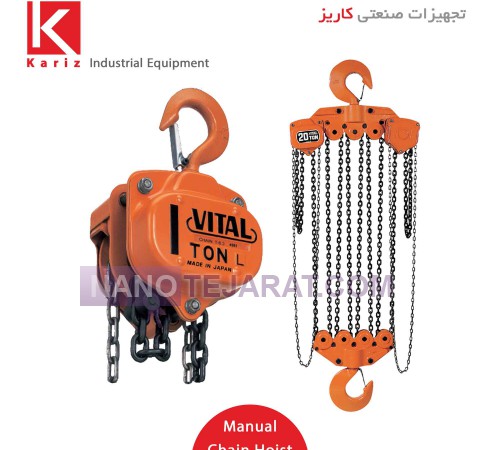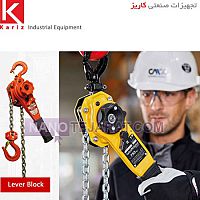
Viewed : 44501
- Tel
- 021-55400161
- | Cell
- 09126645202


| ,Importer,,Wholesaler,Retailer | |
| Tehran | |
| 021-55400161 | |
| kariz_ie | |
| info@karizie.com | |
Import and distribution of German, Japanese, Korean, and Chinese hand weights in Kariz industrial equipment.
Sale of cranes
Hand crane sale
Hand chain crane for sale
Sale of Vital Weapon hand crane
Manual cranes are very efficient tools in the lifting industry that play an important role in providing lifting power. In manual cranes, the lifting force is obtained by the movement of a chain around the pulley, which is also provided by the chain on the operators hand. In this type of crane, chain beads, which must have a suitable grade of steel, are used to lift the load, and the length of these chains is determined as 3 meters and 6 meters by default in the factory, which can be replaced later.
Manual cranes are used in tonnages of 0.5 ton - 1 ton - 1.5 ton - 2 ton - 3 ton - 5 ton and above.
Hand chain crane 0.5 ton 3 meter chain
Hand chain crane, 1 ton, 3 meter chain
Hand chain crane, 1.5 tons, 3 meters chain
Hand chain crane, 2 tons, 3 meters chain
Hand chain crane, 3 tons, 3 meters chain
Hand chain crane, 5 tons, 3 meters chain
Hand chain crane 0.5 ton 6 meter chain
Hand chain crane, 1 ton, 6 meter chain
1.5 ton chain hand crane, 6 meter chain
Hand chain crane, 2 tons, 6 meters chain
Hand chain crane, 3 tons, 6 meters chain
Hand chain crane, 5 tons, 6 meters chain
Manual Chain Hoist: An Essential Component in the Lifting Industry
Introduction:
The lifting industry plays a crucial role in various sectors, including construction, manufacturing, and logistics. Within this industry, manual chain hoists have emerged as indispensable tools for lifting heavy loads safely and efficiently. This essay aims to provide a comprehensive overview of manual chain hoists, their components, and their significance in the lifting industry.
I. Definition and Function of Manual Chain Hoists:
A manual chain hoist is a mechanical device designed to lift heavy objects vertically using a chain mechanism. It consists of several key components that work together to facilitate the lifting process. The primary function of a manual chain hoist is to provide a reliable means of raising or lowering loads with precision and control.
II. Components of Manual Chain Hoists:
1. Load Chain:
The load chain is an integral part of the manual chain hoist, responsible for bearing the weight of the load being lifted. It is typically made from high-strength alloy steel and features links that interlock securely to ensure stability during operation.
2. Hand Chain:
The hand chain is used by operators to manually control the lifting or lowering process. It is connected to the load chain and allows for precise positioning of the load at various heights.
3. Hooks:
Hooks are essential components that enable attachment to the load being lifted. Manual chain hoists typically feature both a top hook for suspending from an overhead support structure and a bottom hook for securing the load.
4. Gear Train:
The gear train consists of gears and sprockets that transmit force from the hand chain to the load chain, allowing for controlled lifting or lowering operations.
5. Brake System:
Manual chain hoists incorporate braking systems that ensure load stability during operation by preventing unintended movement or free-falling of loads when not actively lifted or lowered.
6. Housing/Casing:
The housing or casing encloses all the internal components of the manual chain hoist, providing protection against external elements and ensuring safe operation.
III. Significance of Manual Chain Hoists in the Lifting Industry:
1. Versatility:
Manual chain hoists are versatile tools that can be used in various lifting applications, including construction sites, warehouses, and manufacturing facilities. Their compact size and portability make them suitable for both indoor and outdoor use.
2. Cost-Effectiveness:
Compared to other lifting equipment, manual chain hoists are relatively affordable, making them accessible to a wide range of businesses. Their simplicity also reduces maintenance costs and increases their lifespan.
3. Safety:
Manual chain hoists prioritize safety by incorporating features such as load limiters, overload protection devices, and fail-safe mechanisms. These safety measures minimize the risk of accidents or injuries during lifting operations.
4. Reliability:
Manual chain hoists are known for their durability and reliability in heavy-duty lifting tasks. They can withstand harsh working conditions and provide consistent performance over extended periods.
5. Ease of Use:
With minimal training required, operators can quickly learn how to operate manual chain hoists effectively. The straightforward design allows for intuitive use, reducing the likelihood of errors or mishaps during operation.
Conclusion:
In conclusion, manual chain hoists play a vital role in the lifting industry by providing a safe and efficient means of raising or lowering heavy loads. Understanding the components of these devices is crucial for ensuring proper usage and maintenance. With their versatility, cost-effectiveness, safety features, reliability, and ease of use, manual chain hoists continue to be an essential tool across various sectors where lifting operations are required.
Advantages of Using Bearings in Manual Cranes
Introduction:
Manual cranes are widely used in various industries for lifting and moving heavy loads. These cranes rely on mechanical components to ensure smooth and efficient operation. One crucial component that plays a significant role in the functioning of manual cranes is bearings. Bearings are mechanical devices that reduce friction between moving parts, allowing them to rotate or move with minimal resistance. In this article, we will explore the advantages of using bearings in manual cranes, along with detailed mechanical specifications.
1. Reduced Friction:
One of the primary advantages of using bearings in manual cranes is the significant reduction in friction between moving parts. Friction can cause wear and tear on components, leading to increased maintenance requirements and decreased efficiency. By incorporating bearings into the design, the contact area between moving parts is minimized, resulting in reduced frictional forces. This reduction in friction allows for smoother movement and less energy consumption during crane operation.
2. Increased Load Capacity:
Bearings also contribute to increasing the load capacity of manual cranes. The load capacity refers to the maximum weight that a crane can lift safely without compromising its structural integrity or causing damage to its components. By utilizing high-quality bearings with appropriate load ratings, manual cranes can handle heavier loads efficiently and safely. The load rating specifies the maximum dynamic or static load that a bearing can withstand without failure.
3. Improved Durability:
Another advantage of using bearings in manual cranes is improved durability and longevity of the equipment. Bearings act as protective barriers between different components, preventing direct metal-to-metal contact that can lead to wear and damage over time. By reducing friction and distributing loads evenly across surfaces, bearings help minimize stress concentrations on critical crane parts such as gears, shafts, and axles. This results in extended service life for both the bearings themselves and other crane components.
4. Enhanced Precision:
Precision is crucial when operating manual cranes, especially in applications that require accurate positioning or delicate handling of loads. Bearings play a vital role in achieving this precision by providing smooth and controlled movement. The low friction characteristics of bearings allow for precise control over the cranes movements, enabling operators to position loads with accuracy and minimal effort. This precision is particularly important in industries such as manufacturing, construction, and logistics.
5. Noise Reduction:
Manual cranes often operate in close proximity to workers or within indoor environments where noise levels need to be minimized. Bearings contribute to noise reduction by reducing frictional forces between moving parts. The smooth operation facilitated by bearings results in quieter crane movements, creating a more comfortable working environment for operators and reducing noise pollution in the surrounding area.
Mechanical Specifications:
1. Bearing Types:
There are various types of bearings used in manual cranes, depending on the specific application and load requirements. Some commonly used bearing types include:
- Ball Bearings: These bearings consist of balls sandwiched between two rings inner and outer. They offer low friction and high radial load capacity.
- Roller Bearings: Roller bearings use cylindrical or tapered rollers instead of balls. They are suitable for heavy-duty applications with higher radial or axial loads.
- Thrust Bearings: Thrust bearings are designed to handle axial loads primarily, allowing for smooth rotation under heavy load conditions.
- Slewing Bearings: Slewing bearings are specialized types used in crane slewing mechanisms. They enable 360-degree rotation.
The grade of chain in manual chain hoists is an essential factor to consider when selecting the appropriate hoist for a specific application. The grade of chain refers to the strength and durability of the chain, which directly affects its load capacity and overall performance. In this article, we will discuss the different grades of chain commonly used in manual chain hoists and their respective characteristics.
There are generally three grades of chain used in manual chain hoists: Grade 30, Grade 70, and Grade 80. Each grade has its own unique properties that make it suitable for different lifting applications.
Grade 30 chains are the most common type of chains used in manual chain hoists. They are made from low carbon steel and have a tensile strength of approximately 30,000 pounds per square inch psi. These chains are known for their affordability and versatility. They can handle light to moderate loads and are commonly used in construction sites, workshops, and warehouses where heavy lifting is not required.
Grade 70 chains, also known as transport chains or binder chains, are made from high carbon steel with a tensile strength of around 70,000 psi. These chains are significantly stronger than Grade 30 chains and can handle heavier loads. They are often used in transportation applications such as securing cargo on trucks or trailers. Grade 70 chains have a yellow chromate finish that provides corrosion resistance, making them suitable for outdoor use.
Grade 80 chains are the strongest among the three grades. They are made from alloy steel with a tensile strength of approximately 80,000 psi. These chains offer superior strength-to-weight ratio compared to lower-grade chains. Grade 80 chains can handle heavy loads and are commonly used in industries such as mining, oil and gas, construction, and manufacturing where high-strength lifting is required.
When determining the appropriate grade of chain for a manual chain hoist application, several factors need to be considered. The first is the weight of the load to be lifted. It is crucial to select a chain with a load capacity that exceeds the maximum weight of the load. Overloading a chain can lead to catastrophic failure and pose significant safety risks.
The second factor to consider is the working environment. If the hoist will be used in harsh conditions such as extreme temperatures, exposure to chemicals, or high humidity, it is essential to choose a chain with appropriate corrosion resistance properties. Grade 70 and Grade 80 chains are typically more resistant to corrosion than Grade 30 chains due to their chromate finish and alloy steel composition.
Another consideration is the frequency of use and expected lifespan of the chain hoist. If the hoist will be used frequently or for heavy-duty applications, it is advisable to invest in a higher-grade chain that offers greater durability and longevity. While Grade 30 chains may be suitable for occasional use or light loads, Grade 70 or Grade 80 chains are recommended for continuous use or heavy lifting operations.
In conclusion, selecting the appropriate grade of chain in manual chain hoists is crucial for ensuring safe and efficient lifting operations. The choice of grade depends on factors such as load capacity requirements, working environment conditions, and expected lifespan of the hoist. By carefully considering these factors, one can choose a chain that meets their specific needs and ensures optimal performance and safety in lifting operations.
WEBSITE: Manual Chain Hoist Iran

 Lever Block
Lever Block